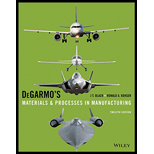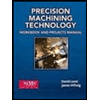
DeGarmo's Materials and Processes in Manufacturing
12th Edition
ISBN: 9781118987674
Author: J. T. Black, Ronald A. Kohser
Publisher: WILEY
expand_more
expand_more
format_list_bulleted
Concept explainers
Question
Chapter 19, Problem 1CS
a.
To determine
The benefits and drawbacks of the traditional low carbon-steel are to be explained.
b.
To determine
The benefits and drawbacks of the advanced high strength steel are need to be explained.
c.
To determine
The benefits and drawbacks of the aluminium need are to be explained.
d.
To determine
The benefits and drawbacks of the polymeric sheet molding compound are to be explained.
Expert Solution & Answer
Want to see the full answer?
Check out a sample textbook solution
Students have asked these similar questions
##2# Superheated steam powers a steam turbine for the production of electrical energy. The steam expands in the turbine and at an intermediate expansion pressure (0.1 Mpa) a fraction is extracted for a regeneration process in a surface regenerator. The turbine has an isentropic efficiency of 90%
Design the simplified power plant schematic
Analyze it on the basis of the attached figure
Determine the power generated and the thermal efficiency of the plant
### Dados in the attached images
### To make a conclusion for a report of an experiment on rockets, in which the openrocket software was used for the construction and modeling of two rockets: one one-stage and one two-stage.
First rocket (single-stage) reached a maximum vertical speed of 100 m/s and a maximum height of 500 m
The second rocket (two-stage) reached a maximum vertical speed of 50 m/s and a maximum height of 250 m
To make a simplified conclusion, taking into account the efficiency of the software in the study of rockets
Determine the coefficients of polynomial for the polynomial function of Cam profile based on
the boundary conditions shown in the figure.
S
a
3
4
5
C₁
(+)
Ꮎ
В
s = q + q { + c f * + q € * + q ( +c+c+c
6
Ꮎ
+C5
+C
β
В
В
0
cam angle 0
B
7
(
Chapter 19 Solutions
DeGarmo's Materials and Processes in Manufacturing
Ch. 19 - What distinguishes sheet forming from bulk...Ch. 19 - What is a definition of shearing?Ch. 19 - Prob. 3RQCh. 19 - What measures can be employed to improve the...Ch. 19 - How does fineblanking create shearing in a...Ch. 19 - Prob. 6RQCh. 19 - What types of cuts are made by squaring shears?Ch. 19 - Why might a long shearing cut be made in a...Ch. 19 - What is a slitting operation?Ch. 19 - What is the difference between piercing and...
Ch. 19 - Prob. 11RQCh. 19 - Prob. 12RQCh. 19 - Prob. 13RQCh. 19 - Prob. 14RQCh. 19 - Prob. 15RQCh. 19 - Prob. 16RQCh. 19 - What is the benefit of making dies as a multipiece...Ch. 19 - Prob. 18RQCh. 19 - Prob. 19RQCh. 19 - Prob. 20RQCh. 19 - Prob. 21RQCh. 19 - Prob. 22RQCh. 19 - When making bends in sheet metal, what is the...Ch. 19 - Prob. 24RQCh. 19 - Prob. 25RQCh. 19 - Why does a metal usually become thinner in the...Ch. 19 - Prob. 27RQCh. 19 - Prob. 28RQCh. 19 - Prob. 29RQCh. 19 - What types of operations can be performed on a...Ch. 19 - Prob. 31RQCh. 19 - Prob. 32RQCh. 19 - Prob. 33RQCh. 19 - Prob. 34RQCh. 19 - What is the primary benefit of incorporating a...Ch. 19 - Prob. 36RQCh. 19 - What is the benefit of using a urethane (rubber)...Ch. 19 - What is the objective of the roll bending process?Ch. 19 - What is the role of the form block in draw bending...Ch. 19 - Prob. 40RQCh. 19 - Prob. 41RQCh. 19 - Prob. 42RQCh. 19 - Prob. 43RQCh. 19 - Prob. 44RQCh. 19 - Prob. 45RQCh. 19 - Prob. 46RQCh. 19 - Prob. 47RQCh. 19 - Prob. 48RQCh. 19 - Prob. 49RQCh. 19 - Prob. 50RQCh. 19 - Prob. 51RQCh. 19 - Prob. 52RQCh. 19 - Prob. 53RQCh. 19 - What is the distinction between shallow drawing...Ch. 19 - What is the function of the pressure ring or...Ch. 19 - Prob. 56RQCh. 19 - Prob. 57RQCh. 19 - Prob. 58RQCh. 19 - Prob. 59RQCh. 19 - Prob. 60RQCh. 19 - Prob. 61RQCh. 19 - Prob. 62RQCh. 19 - Prob. 63RQCh. 19 - Prob. 64RQCh. 19 - Prob. 65RQCh. 19 - Prob. 66RQCh. 19 - Prob. 67RQCh. 19 - Prob. 68RQCh. 19 - Prob. 69RQCh. 19 - Prob. 70RQCh. 19 - Prob. 71RQCh. 19 - Prob. 72RQCh. 19 - Prob. 73RQCh. 19 - Prob. 74RQCh. 19 - Prob. 75RQCh. 19 - What are some of the basic methods that have been...Ch. 19 - Prob. 77RQCh. 19 - Prob. 78RQCh. 19 - Prob. 79RQCh. 19 - Prob. 80RQCh. 19 - Prob. 81RQCh. 19 - What properties from a uniaxial tensile test can...Ch. 19 - How is the formability in biaxial tension...Ch. 19 - What is normal anisotropy, R and planar...Ch. 19 - Prob. 85RQCh. 19 - Prob. 86RQCh. 19 - Prob. 87RQCh. 19 - Prob. 88RQCh. 19 - What two hot�forming operations can be used to...Ch. 19 - Prob. 90RQCh. 19 - What are the primary assets and limitations of...Ch. 19 - Prob. 92RQCh. 19 - Prob. 93RQCh. 19 - What are some of the attractive features of...Ch. 19 - What are some of the common types of press frames?Ch. 19 - What are some features that may be included into a...Ch. 19 - Prob. 97RQCh. 19 - Prob. 98RQCh. 19 - Prob. 99RQCh. 19 - Prob. 100RQCh. 19 - The maximum punch force in blanking can be...Ch. 19 - Prob. 2PCh. 19 - Prob. 3PCh. 19 - What are some of the techniques for minimizing the...Ch. 19 - Prob. 5PCh. 19 - Prob. 6PCh. 19 - Prob. 1CSCh. 19 - Prob. 2CSCh. 19 - Prob. 3CSCh. 19 - Polymeric materials have characteristically low...Ch. 19 - If adhesive bonding is specified as a replacement...Ch. 19 - Which of the material/process options do you feel...Ch. 19 - Prob. 7CSCh. 19 - Prob. 8CS
Knowledge Booster
Learn more about
Need a deep-dive on the concept behind this application? Look no further. Learn more about this topic, mechanical-engineering and related others by exploring similar questions and additional content below.Similar questions
- ### Superheated steam powers a steam turbine for the production of electrical energy. The steam expands in the turbine and at an intermediate expansion pressure (0.1 Mpa) a fraction is extracted for a regeneration process in a surface regenerator. The turbine has an isentropic efficiency of 90% Design the simplified power plant schematic Analyze it on the basis of the attached figure Determine the power generated and the thermal efficiency of the plant ### Dados in the attached imagesarrow_forwardThe machine below forms metal plates through the application of force. Two toggles (ABC and DEF) transfer forces from the central hydraulic cylinder (H) to the plates that will be formed. The toggles then push bar G to the right, which then presses a plate (p) into the cavity, thus shaping it. In this case, the plate becomes a section of a sphere. If the hydraulic cylinder can produce a maximum force of F = 10 kN, then what is the maximum P value (i.e. Pmax) that can be applied to the plate when θ = 35°? Also, what are the compressive forces in the toggle rods in that situation? Finally, what happens to Pmax and the forces in the rods as θ decreases in magnitude?arrow_forwardDetermine the magnitude of the minimum force P needed to prevent the 20 kg uniform rod AB from sliding. The contact surface at A is smooth, whereas the coefficient of static friction between the rod and the floor is μs = 0.3.arrow_forward
- Determine the magnitudes of the reactions at the fixed support at A.arrow_forwardLet Hill frame H = {i-hat_r, i-hat_θ, i-hat_h} be the orbit frame of the LMO satellite. These base vectors are generally defined as:i-hat_r = r_LM / |r_LM|, i-hat_theta = i-hat_h X i-hat_r, i-hat_h = r_LM X r-dot_LMO /( | r_LM X r-dot_LMO | ) How would you: • Determine an analytic expressions for [HN]arrow_forwardDe Moivre’s Theoremarrow_forward
- hand-written solutions only, please.arrow_forwardDetermine the shear flow qqq for the given profile when the shear forces acting at the torsional center are Qy=30Q_y = 30Qy=30 kN and Qz=20Q_z = 20Qz=20 kN. Also, calculate qmaxq_{\max}qmax and τmax\tau_{\max}τmax. Given:Iy=10.5×106I_y = 10.5 \times 10^6Iy=10.5×106 mm4^44,Iz=20.8×106I_z = 20.8 \times 10^6Iz=20.8×106 mm4^44,Iyz=6×106I_{yz} = 6 \times 10^6Iyz=6×106 mm4^44. Additional parameters:αy=0.5714\alpha_y = 0.5714αy=0.5714,αz=0.2885\alpha_z = 0.2885αz=0.2885,γ=1.1974\gamma = 1.1974γ=1.1974. (Check hint: τmax\tau_{\max}τmax should be approximately 30 MPa.)arrow_forwardhand-written solutions only, please.arrow_forward
- In the bending of a U-profile beam, the load path passes through the torsional center C, causing a moment of 25 kNm at the cross-section under consideration. Additionally, the beam is subjected to an axial tensile force of 100 kN at the centroid. Determine the maximum absolute normal stress.(Check hint: approximately 350 MPa, but where?)arrow_forward### Make an introduction to a report of a rocket study project, in the OpenRocket software, where the project consists of the simulation of single-stage and two-stage rockets, estimating the values of the exhaust velocities of the engines used, as well as obtaining the graphs of "altitude", "mass ratio x t", "thrust x t" and "ψ × t".arrow_forwardA 6305 ball bearing is subjected to a steady 5000-N radial load and a 2000-N thrust load and uses a very clean lubricant throughout its life. If the inner race angular velocity is 500 rpm find The equivalent radial load the L10 life and the L50 lifearrow_forward
arrow_back_ios
SEE MORE QUESTIONS
arrow_forward_ios
Recommended textbooks for you
 Precision Machining Technology (MindTap Course Li...Mechanical EngineeringISBN:9781285444543Author:Peter J. Hoffman, Eric S. Hopewell, Brian JanesPublisher:Cengage Learning
Precision Machining Technology (MindTap Course Li...Mechanical EngineeringISBN:9781285444543Author:Peter J. Hoffman, Eric S. Hopewell, Brian JanesPublisher:Cengage Learning

Precision Machining Technology (MindTap Course Li...
Mechanical Engineering
ISBN:9781285444543
Author:Peter J. Hoffman, Eric S. Hopewell, Brian Janes
Publisher:Cengage Learning
Types of Manufacturing Process | Manufacturing Processes; Author: Magic Marks;https://www.youtube.com/watch?v=koULXptaBTs;License: Standard Youtube License